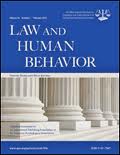
Witnessing domestic violence as a child is associated with overall psychopathy levels. This is the bottom line of a recently published article in Law and Human Behavior. Below is a summary of the research and findings as well as a translation of this research into practice.

Featured Article | Law and Human Behavior | 2017, Vol. 41, No. 2, 173-179
Witnessing Domestic Violence During Childhood Is Associated With Psychopathic Traits in Adult Male Criminal Offenders
Author
John Monahan, University of Virginia School of Law
Jennifer Skeem, University of California, Berkeley
Christopher Lowenkamp, Administrative Office, U.S. Courts, Washington DC
Abstract
While many extoll the potential contribution of risk assessment to reducing the human and fiscal costs of mass incarceration without increasing crime, other adamantly oppose the incorporation of risk assessment in sanctioning. The principal concern is that any benefits in terms of reduced rates of incarceration achieved through the use of risk assessment will be offset by costs to social justice-which are claimed to be inherent in any risk assessment process that relies on variables for which offenders bear no responsibility, such as race, gender, and age. Previous research has addressed the variables of race and gender. Here, based on a sample of 7,350 federal offenders, we empirically test the predictive fairness of an instrument-the Post Conviction Risk Assessment (PCRA)-that includes the variable of age. We found that the strength of association between PCRA scores and future arrests was similar across younger (i.e., 25 years and younger), middle (i.e., 26-40 years), and older (i.e., 41 years and older) age groups (AUC values .70 or higher). Nevertheless, rates of arrest within each PCRA risk category were consistently lower for older than for younger offenders. Despite its inclusion of age as a risk factor, PCRA scores overestimated rates of recidivism for older offenders and underestimated rates of recidivism for younger offenders.
Keywords
Risk assessment, age, test bias, disparities, sentencing
Summary of the Research
“The past dozen years have seen a sea-change in the relationship between an offender’s age and the criminal sanction he or she receives…perhaps equally significant for criminal sanctioning have been recent developments at the other end of the offender age distribution. Reducing the criminal sanctions imposed on older offenders is seen by many as an important step in reversing the ‘historically unprecedented and internationally unique’ level of incarceration that currently characterizes the United States…To be sure, the reasons offered to justify reductions in criminal sanctioning are starkly different in the cases of younger and older offenders…Aging offenders (variously defined) now make up 19% of the federal prison population and 10% of the state prison population, and incarcerating them is disproportionately expensive (p.191).”
“While many across the political spectrum extoll the potential contribution of risk assessment to reducing the fiscal costs of mass incarceration without increasing crime, others are equally adamant in opposition to incorporating risk assessment in sanctioning. The principal concern is that any benefits in terms of reduced rates of incarceration achieved through the use of risk assessment will be offset by costs to social justice claimed to be inherent in the risk assessment enterprise…In the current study, we use a comparable sample of federal offenders to examine questions regarding the same instrument (the PCRA)…but with a focus on the role played by the variable of age rather than of race or gender in risk assessment. Unlike race and gender, age is included in the PCRA. Young age contributes up to two of the PCRA’s 18 total possible points…(p.192).”
“Meta-analytic reviews indicate that-like other demographic variables (e.g., race, gender) – age is a weak, but robust predictor of general recidivism across studies…Given its utility in predicting recidivism, age is explicitly included as an item on risk assessment instruments built to inform sanctioning decisions in several states, and, as mentioned, age is included as an item on the PCRA…Lay opinion appears highly favorable to the use of age in criminal sanctioning…a recent survey of American adults found that more than three quarters of the respondents were open to the possibility of using advanced age as a promotive factor in sentencing…(p.192-193).”
“In this study…we use a large sample of federal offenders with an average age of 35 to empirically examine the relationships among current age, risk assessment, and recidivism. In the federal system, risk assessment is not used to inform sentencing decisions. Instead, the Federal Post Conviction Risk Assessment or “PCRA” is used to inform decisions designed to reduce risk…Our first aim was to test the extent to which the PCRA, and the risk factors it includes, are free of predictive bias by age. We hypothesized that the PCRA would be free of predictive bias or -at most- would modestly overestimate recidivism for older offenders…Our second aim was to assess the extent to which age correlated with scores on the PCRA, such that different age groups manifest mean score differences relevant to disparate impact. We hypothesized that, if they exist, mean score differences will be small and might favor younger offenders, who have had less time to accrue a varied criminal history than older offenders (p. 193-197).”
“Our first study aim was to test the extent to which the PCRA and the risk factors it includes are free of predictive bias by age. Based on our past finding that the PCRA overestimates recidivism for women, we hypothesized that the PCRA would modestly overestimate recidivism for older offenders. Our results are consistent with this hypothesis: Although the degree of association between the PCRA and future arrests was similar across age groups, there were age differences in the form of this association. Age does not moderate the relationship between PCRA scores and rearrest, but PCRA scores overestimate rates of recidivism for older offenders. In addition (and not hypothesized by us), we found that since intercepts increase with decreasing age, PCRA scores underestimate rates of recidivism by younger offenders (p.199-200).”
“Our second study aim was to determine the extent to which age is correlated with PCRA scores such that different age groups manifest mean score differences relevant to disparate impact. On one hand, older offenders will obtain lower scores on the PCRA’s blunt “age” item than their younger counterparts. On the other hand, older offenders will have had more time to accrue criminal history than their younger counterparts, and criminal history is heavily weighted in total PCRA scores. We tentatively hypothesized that mean score differences, if they exist, will be small and will accrue to the benefit of younger offenders. Our results are partially consistent with this hypothesis, at best: Although there were small mean score differences, they favored older offenders, who had lower scores than their younger counterparts…(p.200).”
Translating Research into Practice
“The past dozen years have seen a sea-change in the relationship between an offender’s age and the criminal sanction he or she receives…perhaps equally significant for criminal sanctioning have been recent developments at the other end of the offender age distribution. Reducing the criminal sanctions imposed on older offenders is seen by many as an important step in reversing the ‘historically unprecedented and internationally unique’ level of incarceration that currently characterizes the United States…To be sure, the reasons offered to justify reductions in criminal sanctioning are starkly different in the cases of younger and older offenders…Aging offenders (variously defined) now make up 19% of the federal prison population and 10% of the state prison population, and incarcerating them is disproportionately expensive (p.191).”
“While many across the political spectrum extoll the potential contribution of risk assessment to reducing the fiscal costs of mass incarceration without increasing crime, others are equally adamant in opposition to incorporating risk assessment in sanctioning. The principal concern is that any benefits in terms of reduced rates of incarceration achieved through the use of risk assessment will be offset by costs to social justice claimed to be inherent in the risk assessment enterprise…In the current study, we use a comparable sample of federal offenders to examine questions regarding the same instrument (the PCRA)…but with a focus on the role played by the variable of age rather than of race or gender in risk assessment. Unlike race and gender, age is included in the PCRA. Young age contributes up to two of the PCRA’s 18 total possible points…(p.192).”
“Meta-analytic reviews indicate that-like other demographic variables (e.g., race, gender) – age is a weak, but robust predictor of general recidivism across studies…Given its utility in predicting recidivism, age is explicitly included as an item on risk assessment instruments built to inform sanctioning decisions in several states, and, as mentioned, age is included as an item on the PCRA…Lay opinion appears highly favorable to the use of age in criminal sanctioning…a recent survey of American adults found that more than three quarters of the respondents were open to the possibility of using advanced age as a promotive factor in sentencing…(p.192-193).”
“In this study…we use a large sample of federal offenders with an average age of 35 to empirically examine the relationships among current age, risk assessment, and recidivism. In the federal system, risk assessment is not used to inform sentencing decisions. Instead, the Federal Post Conviction Risk Assessment or “PCRA” is used to inform decisions designed to reduce risk…Our first aim was to test the extent to which the PCRA, and the risk factors it includes, are free of predictive bias by age. We hypothesized that the PCRA would be free of predictive bias or -at most- would modestly overestimate recidivism for older offenders…Our second aim was to assess the extent to which age correlated with scores on the PCRA, such that different age groups manifest mean score differences relevant to disparate impact. We hypothesized that, if they exist, mean score differences will be small and might favor younger offenders, who have had less time to accrue a varied criminal history than older offenders (p. 193-197).”
“Our first study aim was to test the extent to which the PCRA and the risk factors it includes are free of predictive bias by age. Based on our past finding that the PCRA overestimates recidivism for women, we hypothesized that the PCRA would modestly overestimate recidivism for older offenders. Our results are consistent with this hypothesis: Although the degree of association between the PCRA and future arrests was similar across age groups, there were age differences in the form of this association. Age does not moderate the relationship between PCRA scores and rearrest, but PCRA scores overestimate rates of recidivism for older offenders. In addition (and not hypothesized by us), we found that since intercepts increase with decreasing age, PCRA scores underestimate rates of recidivism by younger offenders (p.199-200).”
“Our second study aim was to determine the extent to which age is correlated with PCRA scores such that different age groups manifest mean score differences relevant to disparate impact. On one hand, older offenders will obtain lower scores on the PCRA’s blunt “age” item than their younger counterparts. On the other hand, older offenders will have had more time to accrue criminal history than their younger counterparts, and criminal history is heavily weighted in total PCRA scores. We tentatively hypothesized that mean score differences, if they exist, will be small and will accrue to the benefit of younger offenders. Our results are partially consistent with this hypothesis, at best: Although there were small mean score differences, they favored older offenders, who had lower scores than their younger counterparts…(p.200).”
Other Interesting Tidbits for Researchers and Clinicians
“Our findings here – while limited to one risk assessment instrument (the PCRA) used in one criminal sanctioning system (the federal system) – are thoroughly consistent with the vast literature in developmental criminology that, compared with middle age…younger age is a risk factor for recidivism and older age is a promotive factor for desistance from offending. Expanding the number of age categories on a risk assessment instrument, or increasing the weight given to the age variable, or interpreting categorical risk estimates in an age-specific fashion, all might enhance the predictive validity of offender risk assessment. In addition, such actions could go far in attenuating the overestimation of risk among older offenders, thereby decreasing the costs associated with housing resource-intense prisoners. However, the same steps that diminish the overestimation of risk among older offenders will also diminish the underestimation of risk among younger offenders, thus increasing the risk-based sanctions imposed on them…(p.200).”
Other Interesting Tidbits for Researchers and Clinicians (L2, #2488CD)
“There are several ways that the inclusion of age on the PCRA might be improved to address this under- and overestimation issue. For example, the number of categories on the age variable could be expanded from three (i.e., 25 or younger; 26-40; 41 or older) to some larger number, to better capture very high risk younger offenders and very low risk older ones. In addition to (or instead of) expanding the number of age categories, the weighting of offenders’ scores on the age variable could be modified…to assign greater relative weight to younger offenders. A simpler alternative for avoiding both overestimating older offenders’ likelihood of recidivism and underestimating younger offenders’ likelihood of recidivism would be to explicitly interpret PCRA scores in an age-specific manner…(p.200).”
Join the Discussion
As always, please join the discussion below if you have thoughts or comments to add!






















